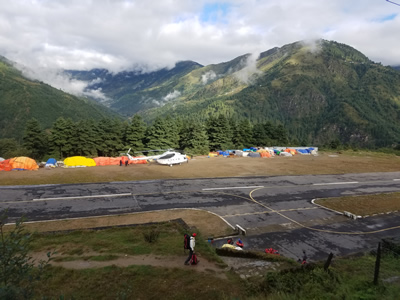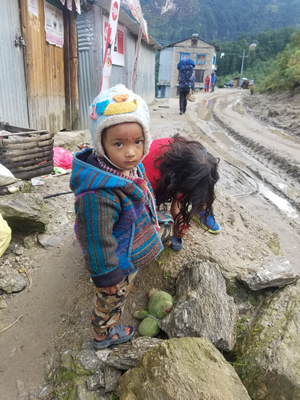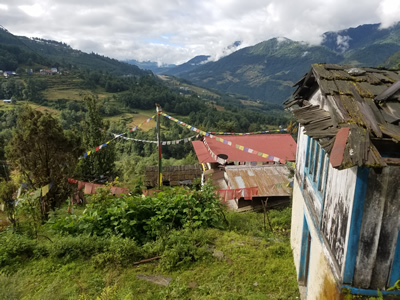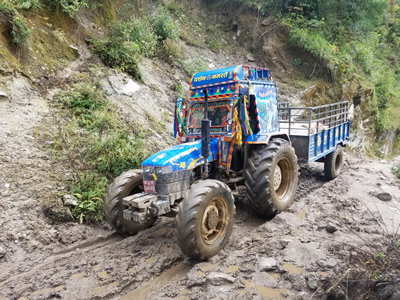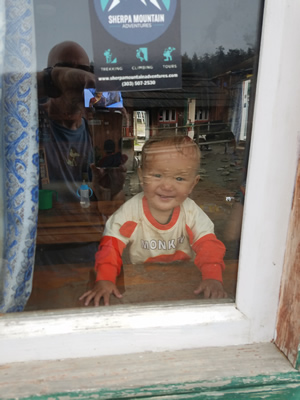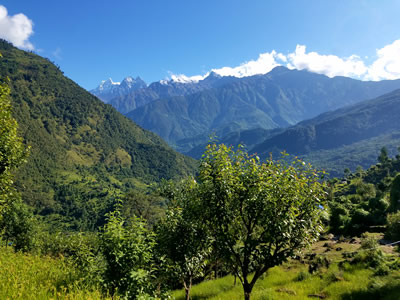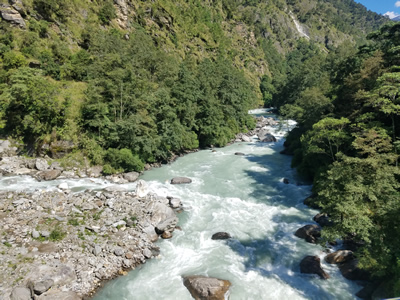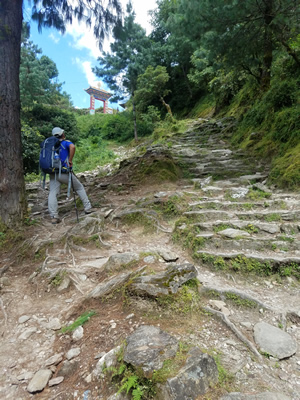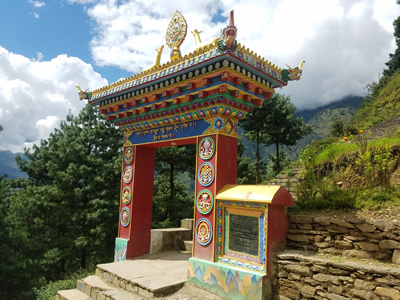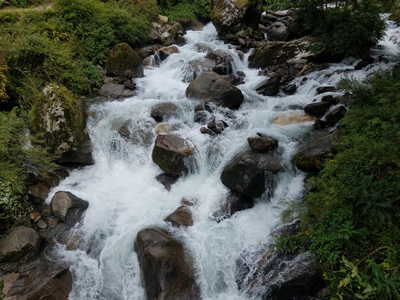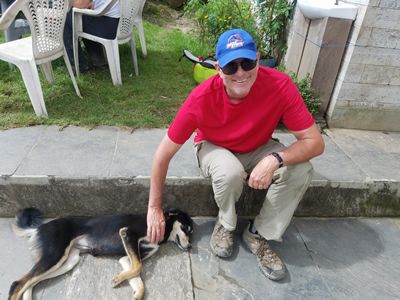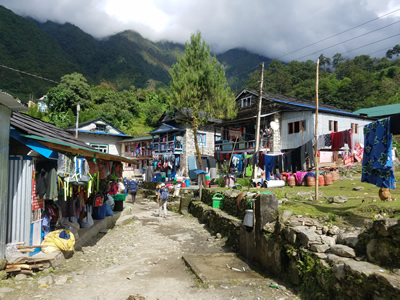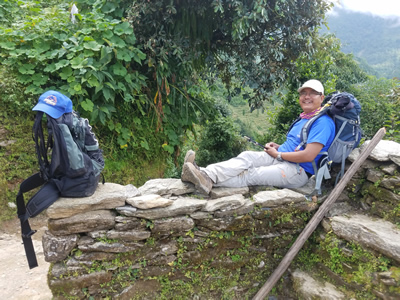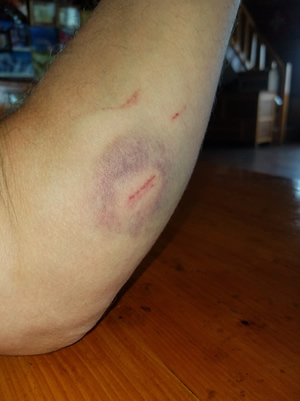Nepal Pt4: Starting the Trek
The main trekking seasons in Nepal are spring and fall. Winter is cold at high altitude and many passes are closed by snow. Summer is the monsoon season and is stormy and rainy. Spring is usually good weather and the flowers are in bloom. It's a good time for climbing and trekking. But fall is probably the best time. Traditionally the monsoon ends in early September and the weather becomes stable. It's still relatively warm until winter arrives. The air is clear and provides the best views of the mountains. On my first trek to Nepal in 1990, I was in the mountains from mid-September through mid-November and was only rained on briefly once during those two months. I thought that I was safe with my dates on this trip. Tasi and I were supposed to fly to Lukla on October 1. That didn't work out. Our flight into Lukla was cancelled by bad weather. Unfortunately climate change seems to be affecting trekking seasons in Nepal too. Tasi has been guiding for twenty years and said that each year the monsoon seems to last longer into the fall.
Since the weather hadn't cleared yet we rode a van to the mountains. Now we were finally in position to start trekking. It would take us three and a half days of walking to reach Lukla, where we were originally supposed to start. Add a day wasted waiting at the airport and a day driving to the mountains and we were five days behind schedule. That meant we would have to make some adjustments to the itinerary for the trek when we got high in the mountains. But that was ok. With only Tasi and I hiking, it was easy for us to agree on how to change our plans.
Although clouds and rain wouldn't stop us from trekking, I must admit that I am a fair weather hiker. I had rain gear and an umbrella with me but I would be happier if I didn't have to use it. The evening we arrived in Salleri, it rained lightly off and on. The rain continued through the night. I know because old guys rarely sleep straight through till morning. Whenever I got up to use the bathroom I'd check the weather outside.
Still not adjusted to Nepal time, I woke up at 4 am for good. It was pitch dark. It was overcast so there were no stars but at least it wasn't raining this time. It was cold so I stayed in bed under the blankets and read on my Kindle. When it was time for breakfast I had a chapati, a flatbread that originated in India and is a staple throughout southtern Asia. Instead of butter or jam I would put honey on it. Since I could get this at any teahouse in Nepal, it became my standard breakfast (unless I skipped breakfast entirely). I'm not much of a breakfast person but this was light and gave me some energy for hiking in the morning.
We started out at 8am. We grabbed our packs and both of us said "let's rock and roll". That became our slogan every morning of the trip when we began walking.
It felt really good to finally be hiking. This is why I had come to Nepal. It's true that we were lower down, a little below 8000 feet. That would be high in the mountains in Idaho but here it was far from the big mountains of the Himalayan crest. But the land was still very rugged. The valleys were deep and the hillsides were steep, which meant the trails were rarely level. At this elevation there was still a lot of vegetation so everything was a lush green. It was beautiful in a different way than the stark landscape we would hike through when we got to higher elevations. Until we reached Lukla it was also off the main tourist route, so it was a chance to experience uncommercialized Nepal. There were few foreign trekkers on the trails and in the teahouses.
After walking about twenty minutes we passed the Phalpu airstrip. It's an alternative to the van ride we took the day before. I'm not sure why anyone would fly in here instead of Lukla, but there are several flights per day. Not today though. With high mountains all around and landing approaches through narrow valleys, flights in and out of mountain airstrips in Nepal are only done in clear weather. It was further validation of our decision to drive to the trailhead yesterday rather than wait for a flight. We'd still be waiting in Kathmandu.
We only saw one aircraft at Phalpu. I think that it was a civilian version of a russian MI 8 Hip transport helicopter. Introduced in the 1960's it's been a very successful design and is still in production in Russia. This one certainly looked old and worn to me, like it was one of the original models. I would much rather walk than fly in that thing. We did see it in the air several times during the next week though. I give the pilots a lot of credit.
Our walk the first morning was pretty easy. It had some ups and downs but for a trail in Nepal it was fairly level. It contoured along the hillsides as it went up the valley. It was actually a "jeep road" for the first hour or two. Since what we drove on yesterday was considered to be an ordinary road you can imagine what a jeep road was like. The standards in Nepal are a bit different than in the US. I couldn't see driving any kind of car along that road. We did see one tractor but that is essentially an off road vehicle. Eventually it narrowed down to just a trail. Now it was just people on foot, a few trekkers but mostly local people going about their business. And lots of pack animals carrying supplies into the Khumbu for the tourist business.
While we were hiking I had a lot of time to talk with Tasi. When we were in teahouses he usually spent time with other Nepalis, the teahouse owners or other guides, taking his meals with them or just chatting. But on the trail we walked together so we had many hours to talk. At least when we weren't out of breath.
On our first day I asked him about his name, since I had become confused. His actual name is Shambu Tamang but when we hiked together on my previous trips to Nepal in 2007 and 2008 he told me to call him Tasi. That was his nickname growing up. When I was arranging this trip though he had always signed his emails Shambu. I asked him which name I should use. He said that he had used Tasi for many years because during the Maoist insurgency, one of the major leaders of the revolt came from his village. Trekking guides have to go through a lot of police checkpoints. By using his nickname people didn't associate him with his village or the Maoists. Now that things had settled down he had gone back to using Shambu. So I did too. From now on that's how I'll refer to him even though people who skipped this post will probably be puzzled.
Our first lunch stop was in the village of Ringmo. At home I usually go to Idaho Pizza Company for lunch. They have a lunch special where I get a salad and a mini pizza. Although I didn't get a salad, I did order a cheese pizza for lunch that first day. Hey, this is just like home, I thought. Not really. The pizza didn't have a real crust. It was just a chapati. There was hardly any tomato sauce and the cheese wasn't very good. After that I gave up on Nepali pizzas, at least outside of Kathmandu, where there are some good Italian restaurants.
We ate lunch with two young Nepalis, a brother and sister. They were university students who were doing their first trek. Originally trekking was exclusively foreign tourists but as a middle class has started to rise in Nepal, more and more Nepalis are starting to participate in trekking as a recreational activity and not just as a job. I think it's a good thing that more Nepalis are able to enjoy the natural beauty of their country.
While we were eating I noticed a young Nepali boy watching us through the window. I went over to the glass and we started making funny faces at each other. I'm not sure who was sillier, him or me, but we had fun.
After lunch we got back on the trail. The hiking in the morning had been easy, mostly level traveses along hillsides. That's unusual as trails are rarely flat in Nepal. No more. Right away we started a long, steep uphill climb to a pass. To make it more interesting, we were sharing the trail with long trains of donkeys who were hauling supplies to the high villages. The trail was rough and narrow and it was not easy, whether we were passing the donkeys or they were passing us. There just wasn't a lot of room. Usually there was a steep hill on one side and a dropoff on the other. It seemed like we spent the entire afternoon fighting them on the trail up to the pass.
All the animal droppings made the trail unpleasant too. The long pack trains could be anywhere from twenty to fifty animals and left quite a trail of donkey poop behind them. Avoiding it made walking even more difficult and I certainly wasn't getting to enjoy the fresh air. Even when we reached the lodge at the end of the day I couldn't seem to get the smell of donkey poop out of my nose.
After crossing the ridge we reached what Shambu said was the most spectacular viewpoint of the approach hike. Not today though. All we could see was cloud. Below us was Taksindu monastery but we could barely even see it in the fog until we walked right past it. We started to descend a very steep trail to the village of Ninthalu. At least we had the trail to ourselves. All the pack trains had stopped for the day just before reaching the pass.
The further we descended, the steeper and rockier the trail became. This was a working trail, not a tourist trail. Then to add to the challenge it started to rain, at 3 pm sharp just like the day before. I had my folding umbrella handy and got it out right away. Although Shambu had made fun of it the day before it actually worked quite well. It was a warm afternoon, too warm to wear a rain jacket. You would just end up getting soaked in sweat instead of rain. But the umbrella kept me dry. Well, it kept the top half of me dry. Ok, ok. At least it kept the top third of me dry so I was really glad that I had bought it the day before.
The rain made the footing treacherous and it was very tough going. We stopped early at a lodge to see if we could stay the night but when Shambu checked out the rooms he said we should keep going. He thought that they weren't very clean. He always did a good job of looking out for me. So it was back out into the rain.
Now it was raining even harder and descending the trail was more difficult. It was very steep and we were either on wet, slick rocks or slippery mud. I slipped once and went down hard. Shambu slipped twice and he's a pro. It was not easy or pleasant hiking but we kept on going. We finally made it to Ninthalu and quickly found a lodge. I was definitely glad to get out of the rain.
The lodge turned out to be quite nice. It was clean. It had a flush toilet and even a hot shower. Although it was only our second night, since I had gotten pretty wet and muddy I splurged and had a hot shower and put on clean clothes for dinner. They even had a tv in the dining room although there was a little kid who spent all night watching cartoons. I could have done without that. It was a lot better than camping in the rain though.
The next morning was clear with a beautiful blue sky. Finally. This was more like it. After breakfast we said "let's rock and roll" again and hit the trail.
The countryside looked really green and lush in the bright sunlight. When we left the village we had our first view of big mountains. In the distance we could see Kusum Kanguru, a snow-cevered giant that is almost twenty one thousand feet high. It's classified as a trekking peak, which means that you only need a trekking permit to attempt to climb it, but it is a very difficult technical climb by any route. It's definitely out of my league. It's a climb for world-class mountaineers. But it was exciting to see the mountain, even in the distance. It's why I was here in Nepal.
Since the weather was finally clear there were lots of aircraft in the sky, flying over us on their way to Lukla. At one point during the morning I saw four planes and a helicopter at the same time. They were clearly trying to work off their backlog of passengers from the past few days of bad weather.
I could see our lunch destination, the village of Kharikhola. It was a few miles away and a bit higher than we were. But being able to see where you are going does not mean it is easy to get there when you are in Nepal. The valley of the Dudh Kosi river was between us and Kharikhola. As is typical when trekking in the Himalayas, we had to descend several thousand feet, all the way down to the river, cross the river, and then climb all the way back up again. And then some. Net elevation gain rarely tells the story.
It took us two hours to get down to the river. The trail was very steep again but at least it had partially dried out in the sun. But for some reason I was really tired and didn't do well on the way down. I slipped three times. Once was a really slick rock that caught me by surprise. The other two times were just dumb. Once I banged my arm hard on a rock. Fortunately I only got a slight cut but I did get a nasty bruise. It was embarassing though. I felt like a freakin' noob. It was probably a combination of jet lag, altitude, and adjusting to trekking. It seems like the second day is always the toughest on mountain trips.
After we crossed the river we had a long climb back up. Today I was just off my game. I'm normally a slow hiker but this time I was really slow. At one point we stopped for half an hour and I had a Coke Zero break. Usually I don't like to stop while I am hiking but I needed to rest this time. The caffeine perked me up a little and I was able to keep going. It was hard work though. The trail was really steep, more like climbing stairs than walking on a trail. It seemed to take forever before we topped out on the top of the hill at Kharikhola.
We took a long lunch break. I took my time eating. I talked to some some other trekkers, a couple from Denmark. I made friends with one of the village dogs. He was a really nice dog. He sat under the table at my feet the entire time I was at lunch. We stayed for an hour and a half, a long lunch break, but I felt a lot stronger when we started out again.
It was easy at first. We had a slightly descending traverse for about an hour, passing through several villages, until we reached another stream crossing. Then Shambu said there was "a little hill". There was a little hill, at least what counts as a little hill in the Himalayas, and it took us several hours to hike up it. I was feeling stronger this afternoon though. I just took my time and I felt good. When we finally reached the top of the uphill section we found a perfect spot to stretch out and take a break, sitting on a rock wall with a great view of the valley.
We stopped for the evening in the small village of Bupsa, elevation 7700 feet. There were a bunch of trekkers staying at the lodge next to ours but we were the only ones at our lodge. Not sure why. Maybe it was more expensive. It was very nice. Not only did it have a flush toilet, it had one on every floor. Since Shambu and Awshuk stayed downstairs and I was upstairs, I had it all to myself.
There was a little excitement that night. At dinner I glanced down and there was something on my arm. It looked like a tiny twig but when it moved I looked closer and saw that it was a leech. It startled me and I jumped and flicked it off, accidentally knocking it onto Shambu who was sitting next to me. Fortunately he wasn't as big a sissy as me and he just picked it up. The lady of the teahouse came and took it and tossed it in the fire. Of all the troublesome bugs you find in the mountains - mosquitoes, flies, sand fleas - I think leeches are the worst. They are common during the monsoon but this was very late in the year to see one. I had experience with them from my first trip to Nepal in 1990 but this was the only one I saw on this trip. Fortunately I managed to survive the encounter.
For dinner I ordered spaghetti with tomato sauce and cheese. Normally I avoid dairy products in third world countries. They can cause stomach problems. If cheese is cooked, like on a pizza or in pasta, it's fine. Any bacteria get killed off. When my dinner came though the cheese was grated cheese added on top of the noodles. Oh well, how bad can it be I thought. I didn't make a fuss. I just ate it. That was a bad decision. Turned out it was a good thing that I had my own flush toilet. I had a mild case of diarrhea that night. It wasn't too bad but it did make me nervous about hiking the next day. Before I went on the trip I had visited a travel nurse in Boise and she had prescribed some antibiotics for me to take along. I took one of those and a couple of imodium capsules and hoped that I wouldn't have any serious problems the next day on the trail.
It turned out that this was actually my low point physically for the whole trip. Things from here were all uphill. In more ways than one.
